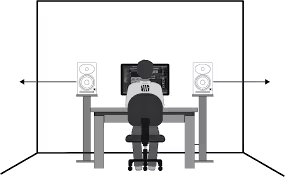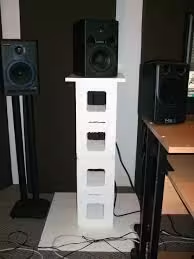
The key to precision in sound may be right under your speakers!
Setting up a home studio is exciting—getting your gear, placing your monitors, and diving into the mix. But are studio monitor stands important?
Absolutely. It’s easy to overlook them, but this simple addition could make or break the clarity of your sound. Do studio monitor stands affect sound quality? You bet they do. When you place your monitors directly on your desk, you’re not just hearing the mix; you’re hearing unwanted vibrations and resonance from the desk itself.
Here’s the thing: a desk might seem convenient, but it’s a no-no for professional mixing. Desks resonate at certain frequencies based on their size and shape, muddying your sound. That’s where monitor stands studio setups come in—they isolate your speakers, giving you more accurate playback. If precision matters to you (and it should), it’s time to elevate your sound—literally!
What Are Studio Monitor Stands?
Studio monitor stands are an often overlooked yet essential tool in any serious mixing setup. Unlike regular stands, monitor stands studio setups are specifically designed to enhance sound accuracy by isolating your monitors from unwanted vibrations and reflections.
Their primary job is to support your studio monitors at the perfect height and angle, ensuring you hear the most accurate representation of your mix. But why are they so important? Let’s dig into the details of how they work and why they differ from your average speaker stands.
Breaking Down the Basics: What Exactly Are Monitor Stands?
At their core, studio monitor stands are platforms designed to hold your studio monitors in place while reducing sound interference caused by desk vibrations or floor reflections. By elevating your speakers to the ideal height, they ensure your ears align perfectly with the sweet spot—where sound is clearest.
These stands are often sturdy, and designed with isolation pads to minimize vibrations. Whether you’re mixing music, editing sound, or producing, using monitor stands ensures you’re getting a true representation of your sound without distortions caused by poor positioning or surface interference.
How Studio Monitor Stands Differ from Regular Stands
While both types of stands serve the basic function of supporting speakers, monitor stands studio designs offer more precision. Regular speaker stands are often built with aesthetics in mind, focusing on looks rather than sound isolation.
In contrast, studio monitor stands are engineered with acoustics in mind. They feature materials that absorb vibrations and can be fine-tuned for height and angle, ensuring you achieve an optimal listening position. This attention to detail makes a world of difference when you’re working on professional mixes.
Why Position Matters in Mixing

When it comes to achieving a clean, balanced mix, are studio monitor stands important? They are crucial. Many home studio enthusiasts skip this crucial setup, but your monitor placement can be the difference between a clear mix and a muddled mess.
Another issue is using wobbly, cheaply-made stands with large studio monitors. This is a huge no-no. Every time your monitors wobble, it interferes with your bass response and overall frequency balance. Your stands must be stable and sturdy—if not, your sound quality takes a serious hit. Let’s break down why monitor stands studio setups play a key role in sound accuracy.
Sound Waves and Sweet Spots: The Role of Monitor Placement

Sound waves don’t just travel in a straight line—they bounce, reflect, and interact with your room’s surfaces. This is where the “sweet spot” comes in, the exact position where sound is the most accurate. Proper monitor placement ensures you’re hearing your mix exactly as it is, without distortions from reflections or room interference.
Using studio monitor stands allows you to position your monitors at ear level, ensuring you’re right in the sweet spot. This precise placement is what helps your ears pick up on the subtle details in your mix, from stereo imaging to frequency response. Without the right height and angle, you could be missing crucial elements.
How Poor Positioning Can Mess Up Your Mix
Placing your monitors directly on your desk or using unstable, wobbly stands is a recipe for disaster. Poor positioning causes sound waves to reflect off surfaces, altering your perception of the mix.
You’ll experience inconsistent bass response, muddied mids, and inaccurate highs—all of which affect your ability to create a well-balanced track.
Do studio monitor stands affect sound quality? Without question. Even the slightest shift in your monitor’s angle or height can mess with your stereo image and frequency response, resulting in a mix that sounds off in different environments.
The Secret Weapon You Didn’t Know You Needed for Mixing
Here’s the game-changer: how critical your studio monitor stands are to achieving professional-level sound can’t be overstated. Stable, well-positioned stands are your secret weapon. They allow you to hear a true representation of your mix, free from unwanted vibrations and reflections.
With the right stands, your monitors are isolated from your desk or floor, giving you a clearer, more defined sound. If you’re aiming for precision in your mixes, investing in proper monitor stands isn’t just a luxury—it’s a necessity.
The Science Behind Studio Monitor Stands

Studio monitor stands might seem like an optional accessory, but if you’re serious about your sound, they’re non-negotiable. You wouldn’t build a house without a solid foundation, right? Well, the same goes for your mixing setup. How critical your studio monitor stands are can’t be understated—they’re the key to isolating your monitors and preventing sound interference.
Many DIY setups use cinder blocks for a reason: they’re solid, don’t wobble, and most importantly, don’t resonate. Unfortunately, many hollow stands on the market ring or resonate at certain frequencies, causing unwanted vibrations that blend with your monitors’ output and mess with your sound. To get the most out of your monitors, isolation and stability are crucial. Let’s explore why this makes such a big difference.
Isolation and Vibration: Why Stability Affects Sound Quality
Vibrations might seem harmless, but when it comes to audio clarity, they can wreak havoc on your mix. Unstable stands transfer vibrations from your monitors to the desk or floor, adding unwanted resonance that interferes with your frequency response. It’s like adding a low hum or buzz to your mix—it distorts the bass and blurs the mids.
Stable studio monitor stands are designed to isolate your speakers, preventing this kind of sound pollution. By eliminating unwanted vibrations, you hear only the sound coming from your monitors, allowing for a more accurate mix. This is why solid stands, whether DIY cinder blocks or professional-grade stands, are essential for keeping your sound clean and uncolored.
Why Elevating Your Monitors Changes the Entire Game
Elevating your monitors isn’t just about getting them off your desk; it’s about positioning them perfectly for optimal sound. When your monitors are too low, sound waves bounce off surfaces like your desk, creating reflections that interfere with what you’re hearing. By elevating your monitors to ear level, studio monitor stands ensure that you’re in the “sweet spot,” where the sound is most accurate.
This allows for better stereo imaging and more precise control over your mix. Elevation not only reduces the impact of reflections but also helps to distribute the sound evenly across the room, so you can trust what you’re hearing. It’s a small adjustment that can completely transform the quality of your mixes.
Better Sound Clarity with Studio Monitor Stands

Why are studio monitor stands important? If you’re serious about achieving professional-level mixes, they are an absolute game-changer. One of the most crucial factors to consider when choosing stands is weight. Heavier stands provide better sound imaging and sharper transients, which are essential for clean, precise audio.
For example, my DIY stands filled with lead shot weigh about 70 pounds each, and the sound clarity is remarkable. Whether you go the DIY route or invest in high-quality stands, look for ones that can be filled for added stability. This way, you’re set up to experience improved sound isolation and clearer mixes.
Avoiding Distorted Bass and Muddy Frequencies
When your monitors are placed directly on a desk or wobbly stands, the first thing to suffer is your bass response. The desk resonates, the stands wobble, and the result is an inconsistent low-end that’s either too boomy or too thin.
Studio monitor stands are designed to isolate your speakers, reducing vibrations and preventing distorted bass. With sturdy stands, your monitors can deliver a tight, controlled low end, free of the muddy frequencies that can interfere with your mix. Whether you’re working on punchy drums or deep basslines, the stability of your stands ensures that what you hear is what you get—no unwanted resonances muddying the waters.
Precision Listening: Hear the Details in Your Mix
Every producer knows that the magic is in the details. Whether it’s subtle reverb tails, delicate high-hat patterns, or the perfect stereo spread, you need to hear your mix with pinpoint precision. Poor monitor placement can blur these details, leading to an inaccurate representation of your work.
By using studio monitor stands, you elevate your monitors to ear level, providing a direct path from speaker to ear without interference from reflections or vibrations. This allows for a more precise listening experience, where you can accurately judge every element in your mix. You’ll catch the subtleties that make a track truly shine, ensuring that your mix translates perfectly across different playback systems.
How Monitor Stands Help You Achieve Accurate Stereo Imaging

When it comes to mixing, getting an accurate stereo image is essential—and studio monitor stands are a key player in making that happen. Well-designed stands not only provide stability but also acoustically decouple your speakers from the surface they’re placed on.
This isolation reduces vibrations that can muddy up your sound and distort the stereo image. By allowing you to position your monitors at the optimal height and angle, stands help your speakers translate the sound more accurately in your room.
So, do studio monitor stands affect sound quality? Absolutely. They help create a clear, focused sound stage, making it easier to place instruments and effects precisely within your mix.
Creating the Perfect Sound stage with Monitor Stands
A well-balanced mix isn’t just about getting the EQ right; it’s also about how your sounds sit in the stereo field. Studio monitor stands allow you to place your speakers in the ideal position for creating a perfect sound stage, where every element in your mix has its own space. By lifting your monitors off the desk and away from reflective surfaces, you minimize phase issues and frequency smearing.
This results in a more natural, well-defined stereo image where instruments can be placed with pinpoint accuracy. With properly positioned stands, you’ll notice a dramatic improvement in how wide and deep your mix sounds, giving you that professional, immersive sound stage you’re aiming for.
Why Angling Your Monitors Matters for Balance
Monitor placement isn’t just about height—angling your monitors correctly is just as crucial. If your monitors are angled improperly, you might lose clarity in one ear, making your mix sound off-balance.
Properly angled studio monitor stands help ensure that both speakers are aimed directly at your listening position, giving you a perfectly balanced stereo image.
This setup helps you hear the mix equally in both ears, allowing you to make more precise adjustments to panning and spatial effects. By focusing on positioning and angling, you can avoid uneven mixes and achieve the clarity and balance your music deserves.
Choosing the Right Studio Monitor Stands for Your Setup
When setting up your mixing environment, you might be asking yourself, are studio monitor stands important? The answer is a resounding yes! One of the key features to consider when buying monitor stands is weight.
The heavier the stand, the better it performs in isolating your monitors from unwanted vibrations. A massive stand acts as an “anchor,” stabilizing your speakers and preventing any frequency from traveling through it to the floor or walls, which can create unwanted resonances.
The goal is to have your monitors deliver pure, uncolored sound without interference from the environment around them. So, when shopping for monitor stands, prioritize those that are heavy and sturdy, as they will significantly enhance the quality of your monitoring experience.
Key Features to Look for When Buying Monitor Stands: Heavy, Sturdy
When you’re on the hunt for monitor stands, several key features will ensure you’re making a wise investment. First and foremost, look for heavy stands—ideally, those that weigh at least 30 to 50 pounds. The more massive the stand, the less likely it is to transmit vibrations, ensuring your speakers deliver accurate sound without distortion.
Next, sturdiness is crucial; a well-built stand should be made of durable materials that can withstand the weight of your monitors without wobbling.
Additionally, check for adjustable heights and angles. This flexibility allows you to position your monitors at ear level for optimal listening. Finally, consider designs that provide stability while minimizing resonance, such as solid wood or metal stands with a dense core. With these features in mind, you can confidently select monitor stands that will elevate your mixing experience!
DIY vs. Store-Bought Monitor Stands: Which Is Better?

When it comes to studio monitor stands, the decision between DIY and store-bought can be tough, but both have their perks. If you’re on a tight budget, DIY stands are a fantastic option. Personally, I recommend going the DIY route because it’s not only cheaper, but you’ll also notice a significant difference in sound quality.
Simple materials like cinder blocks or PVC pipes filled with sand create a sturdy, vibration-free base for your monitors. It’s a night-and-day improvement in stability and clarity. However, if you prefer the convenience of store-bought options, there are plenty of budget-friendly models that still deliver solid results without breaking the bank.
Can You Build Your Own Stands? Pros and Cons
DIY monitor stands are an affordable and customizable option. The pros? You save money, and you can build them to your exact specifications. Cinder blocks, for example, are cheap and offer excellent stability due to their weight. PVC pipes filled with sand work well too, providing a solid base with minimal resonance.
However, the cons include a more basic appearance, and some DIY projects may require a bit of effort and time. But if you’re looking to save some cash and improve your sound, DIY stands are definitely worth considering!
Budget-Friendly Store-Bought Options That Work
Not feeling the DIY life? No worries, there are plenty of budget-friendly studio monitor stands on the market that still offer solid performance. Look for models that are sturdy, height-adjustable, and capable of isolating vibrations. Brands like On-Stage and Ultimate Support have great affordable options that provide decent stability without emptying your wallet. While they might not match the custom feel of a DIY stand, store-bought stands can be a quick and easy solution if you’re pressed for time or don’t want to tackle a DIY project.
Final Tips: Making the Most of Your Monitor Stands
So, are studio monitor stands important? Absolutely—and here’s why: placing your monitors directly on a desk causes vibrations to travel through the surface, creating an unwanted low-end rumble that distorts what you’re hearing. These subtle yet significant vibrations lead to inaccurate mixes, as you’re not just hearing the pure sound from your monitors but also the resonance from the desk.
Proper studio monitor stands eliminate this issue, isolating your monitors and ensuring you’re only hearing the sound they’re producing. Another critical factor is positioning—placing your monitors at the correct ear level not only improves sound quality but also reduces ear fatigue.
Misalignment causes you to strain your ears over time, which can lead to poor decisions in EQ, compression, and stereo imaging. Do studio monitor stands affect sound quality? Without a doubt. If you want to get the best out of your gear, how critical your studio monitor stands are cannot be overlooked.
FAQ
Why are studio monitor stands important for mixing?
Studio monitor stands are essential for improving sound accuracy. They isolate your monitors from surfaces that can cause unwanted vibrations, ensuring you hear only the true sound your monitors produce, leading to more precise mixing.
Do studio monitor stands affect sound quality?
Yes, studio monitor stands play a key role in improving sound quality. By decoupling your monitors from the desk or floor, they prevent resonance and low-end rumble, which can distort the clarity of your mix.
Can I just place my studio monitors on a desk?
Placing monitors directly on a desk is not recommended. Desks can resonate and create additional low frequencies, muddying your sound. Monitor stands eliminate this issue and ensure optimal sound reproduction.
Are expensive studio monitor stands necessary?
Not necessarily. While high-end stands can offer additional features, even budget-friendly or DIY stands can significantly improve sound quality if they provide proper isolation and stability.
How should I position my studio monitor stands for the best sound?
Position your studio monitor stands so that your monitors are at ear level and form an equilateral triangle with your listening position. This ensures accurate stereo imaging and minimizes ear fatigue.
Conclusion
Elevate your mixing game by understanding why are studio monitor stands important in your setup. These stands aren’t just a minor detail—they’re a crucial part of achieving a clean, professional mix. Investing in solid studio monitor stands eliminates unwanted vibrations, helps you avoid ear fatigue, and gives you more accurate sound monitoring. The result? You can make better mixing decisions, improving the overall quality of your projects. Don’t let this often-overlooked accessory hold back your mix! It’s a small investment that delivers big results in sound clarity and precision.
